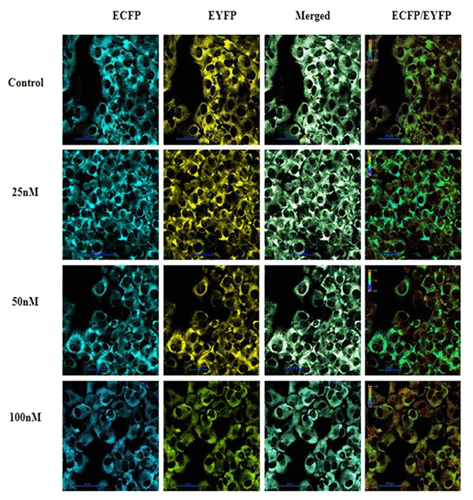当前位置:
X-MOL 学术
›
J. Proteome Res.
›
论文详情
Our official English website, www.x-mol.net, welcomes your feedback! (Note: you will need to create a separate account there.)
VDAC1 and SERCA3 Mediate Progesterone-Triggered Ca2+ Signaling in Breast Cancer Cells
Journal of Proteome Research ( IF 4.4 ) Pub Date : 2017-12-22 00:00:00 , DOI: 10.1021/acs.jproteome.7b00754 Juberiya M. Azeez 1 , Ravindran Vini 1 , Viji Remadevi 1 , Arun Surendran 1 , Abdul Jaleel 1 , T. R. Santhosh Kumar 1 , S. Sreeja 1
Journal of Proteome Research ( IF 4.4 ) Pub Date : 2017-12-22 00:00:00 , DOI: 10.1021/acs.jproteome.7b00754 Juberiya M. Azeez 1 , Ravindran Vini 1 , Viji Remadevi 1 , Arun Surendran 1 , Abdul Jaleel 1 , T. R. Santhosh Kumar 1 , S. Sreeja 1
Affiliation

|
Progesterone is a biphasic hormone whose confounding role in breast cancer cells involves an initial proliferative surge, followed by sustained growth arrest. Recently we reported that progesterone induces a time- and concentration-dependent release of reactive oxygen species and thus regulates the antiproliferative activity in the breast cancer cell line. Furthermore, the expression of p27, a crucial cell cycle control protein, was regulated by binding of progesterone on progesterone receptor B, thus leading to antiproliferative signaling via multiple signaling pathways including p53, PTEN, and antioxidant systems. Here, we performed an LC–MS/MS analysis of three different breast cancer cell lines. Bioinformatics data analysis and functional classification of proteins revealed a role of progesterone in calcium signaling in MCF-7 cells, and the major differentially expressed calcium regulators were S100A11, S100A10, calreticulin, VDAC1, SERCA3, and SERCA1. Later on we confirmed it by a cell-line-based system having a calcium cameleon sensor targeted at endoplasmic reticulum and found moderate calcium efflux from endoplasmic reticulum upon progesterone treatment. Real-time PCR, Western blot, and TMRM staining confirmed the role of calcium signaling regulators VDAC1 and SERCA3 in progesterone response. Taking together all of these results with our previous studies, we suggest that progesterone, by regulating important proteins involved in calcium signaling and transport, can modulate cell proliferation and cell death. Furthermore, our research may open new avenues for the hypothesis that surgery conducted during the luteal phase of the menstrual cycle might facilitate improved patient survival.
中文翻译:

VDAC1和SERCA3介导孕激素触发的Ca2 +信号在乳腺癌细胞中。
孕酮是一种双相激素,在乳腺癌细胞中的混杂作用涉及最初的增殖激增,然后持续的生长停滞。最近,我们报道了孕酮诱导活性氧的时间和浓度依赖性释放,从而调节乳腺癌细胞系的抗增殖活性。此外,p27(一种至关重要的细胞周期控制蛋白)的表达受到孕酮与孕激素受体B的结合的调节,从而通过包括p53,PTEN和抗氧化剂系统在内的多种信号途径导致抗增殖信号传导。在这里,我们对三种不同的乳腺癌细胞系进行了LC-MS / MS分析。生物信息学数据分析和蛋白质功能分类揭示了孕酮在MCF-7细胞的钙信号传导中的作用,主要的差异表达钙调节剂是S100A11,S100A10,钙网蛋白,VDAC1,SERCA3和SERCA1。后来我们通过基于细胞系的系统证实了这一点,该系统具有针对内质网的钙骆驼钙传感器,并在黄体酮治疗后从内质网中发现适度的钙外流。实时PCR,蛋白质印迹和TMRM染色证实了钙信号调节因子VDAC1和SERCA3在孕酮反应中的作用。综合所有这些结果和我们以前的研究,我们建议孕酮通过调节参与钙信号传导和转运的重要蛋白质,可以调节细胞增殖和细胞死亡。此外,
更新日期:2017-12-22
中文翻译:

VDAC1和SERCA3介导孕激素触发的Ca2 +信号在乳腺癌细胞中。
孕酮是一种双相激素,在乳腺癌细胞中的混杂作用涉及最初的增殖激增,然后持续的生长停滞。最近,我们报道了孕酮诱导活性氧的时间和浓度依赖性释放,从而调节乳腺癌细胞系的抗增殖活性。此外,p27(一种至关重要的细胞周期控制蛋白)的表达受到孕酮与孕激素受体B的结合的调节,从而通过包括p53,PTEN和抗氧化剂系统在内的多种信号途径导致抗增殖信号传导。在这里,我们对三种不同的乳腺癌细胞系进行了LC-MS / MS分析。生物信息学数据分析和蛋白质功能分类揭示了孕酮在MCF-7细胞的钙信号传导中的作用,主要的差异表达钙调节剂是S100A11,S100A10,钙网蛋白,VDAC1,SERCA3和SERCA1。后来我们通过基于细胞系的系统证实了这一点,该系统具有针对内质网的钙骆驼钙传感器,并在黄体酮治疗后从内质网中发现适度的钙外流。实时PCR,蛋白质印迹和TMRM染色证实了钙信号调节因子VDAC1和SERCA3在孕酮反应中的作用。综合所有这些结果和我们以前的研究,我们建议孕酮通过调节参与钙信号传导和转运的重要蛋白质,可以调节细胞增殖和细胞死亡。此外,


























 京公网安备 11010802027423号
京公网安备 11010802027423号